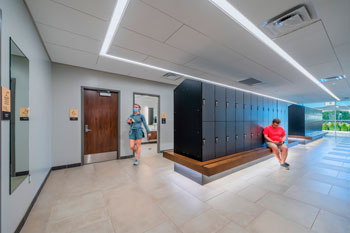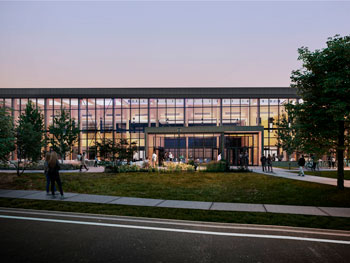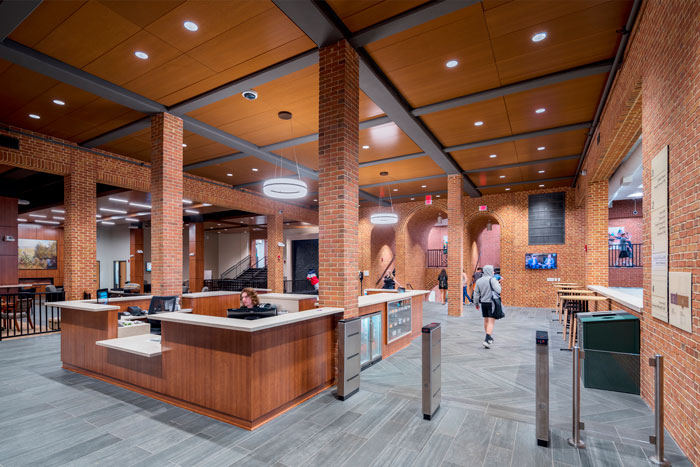At the end of the day, sports are supposed to be fun. Spectators at sporting events want to have an enjoyable and relaxing time taking in a game, while athletes want to focus on training and practicing to become the best they can be at their sport, and reap the rewards of their hard work. But there’s a whole army of others who are working behind the scenes to keep spectators safe and make sure players stay healthy and injury-free.
St. Charles North is a high school with around 2,000 students located in St. Charles, Ill. Joe Benoit is the athletic director at North, and he said the safety of student-athletes, coaches and spectators is their top priority, therefore they rely on a team of people to inspect and care for their roughly 60-acre campus and indoor facilities.
“Outside, our grounds team has established routines both in and out of season for our bleacher areas, press boxes, fields, tennis courts and turf. Inside, our custodial and maintenance team have both daily plans and preventive maintenance plans that look at every corner of our athletic facilities with a critical eye.” He said any concerns are discussed at their weekly operations meetings; issues that can be remedied immediately are delegated, while plans are made for fixes that might require outside resources.
Athletic directors wear many hats, and communicate with student-athletes, parents, administrators, facility operators and sports medicine personnel. And according to Benoit, one of the most important aspects of his job is hiring, which includes coaches. “We seek coaches who put the student-athlete first and understand that true partnership that needs to exist with parents, the community and our school in order for everyone to be on the same page. Our coaches have a reflective mindset focused on every aspect of the development of our student athletes, from safety to preparing our kids for life using the many lessons that sports can facilitate.”

While pro sports teams have state-of-the-art training facilities and myriad health specialists, even smaller colleges these days have robust sports medicine teams including trainers, strength and conditioning coaches, doctors, surgeons, nutrition specialists, mental health experts and more. And high schools continue to advance in this area, with Benoit telling us that most similarly sized schools have at least one athletic trainer on staff. “We have two full-time athletic trainers who specialize not only in rehabilitation but also injury prevention. Our trainers are at all home events on campus, including practices and competitions.”
Student-athletes at North must complete an annual physical before participating. Strength and conditioning is key to preventing injuries and avoiding overuse, and Benoit said this is an area that’s stressed. “We’re fortunate to offer several wellness courses during the school day as well as a strength and conditioning coach after school who works with our student-athletes in preparation for upcoming seasons. The focus of the training is on building strength, flexibility and conditioning for injury prevention and peak performance.” They also stress things like nutrition, hydration and rest, which also lead to better conditioning, less fatigue and injury prevention.
And what about security and spectator safety—is this an area that athletic directors are involved with?
“Yes, absolutely,” said Benoit. “We discuss spectator safety at our weekly operations meetings and with our event staff several days prior to an event and the day of when they report. This is such a critical aspect that we don’t overlook. I also involve our school resource officer and athletic trainers in our planning and development of our emergency action plan which is a comprehensive plan encompassing all aspects of our safety responses and prevention.”
He said they also have Emergency Medical Services (EMS) at all football games and police support as well at large community games.
Western Michigan University (WMU) is an NCAA Division l school with a proud sports history. They operate several sports venues including Waldo Stadium, which can hold 30,000-plus football fans, and University Arena, which accommodates nearly 5,500 spectators indoors. Matt Kulik is the assistant athletic director for facilities, and he said their Department of Public Safety officers take the lead when it comes to event security. “The department has about 30 full-time sworn officers who are employed by WMU.”
Kulik said their department works with the public safety arm on a daily basis for their events. “They’re involved in all our pre-season meetings and planning sessions; they provide input and are great resources to bounce ideas off of. For large events like football, they would then connect other local agencies to work the games. It’s a large undertaking getting everybody on the same page with their tasks, and making sure everyone utilizes the same radio channels and traffic.”
Last year was the first time WMU used an outside vendor for ushers and event staffing at ticketed sporting events, and Kulik said that training was a large part of the onboarding process for them. “Training needs to be a continual thing; there are so many variables, and so many different situations to cover.”

Training is shared between Athletics, the staffing company and the Public Safety Department, which “has an emergency manager who provides a lot of resources for emergency situations. We have our procedures for how we want this to run on gameday and we set that standard with the staffing company.”
Being able to communicate with large crowds is a major consideration, and Kulik said they have scripted P.A. announcements and scoreboard messages ready for emergency situations like weather or shelter-in-place events. “It’s one of those things you hope you never have to use, but you need to be prepared.”
And when it comes to screening, he said they were an early adopter of the clear bag policy, which many more facilities are now using. “We’ve never done bag checks at basketball and hockey and that’s something we’re doing this year. It’s definitely a learning curve and something that takes time for people to get used to.”
Bomb-sniffing dogs are also utilized at football games, and Kulik explained how they lock down the stadium four hours prior to kickoff, at which point you must have credentials to enter as police are stationed at each gate. Then the K9 team—along with the Kalamazoo bomb squad—do a full search of the stadium, including locker rooms, press box and suites. “This ensures that if they were to find something, we have the resources on hand to investigate.”
Fans are allowed in 90 minutes before kickoff. K9 teams also roam the stadium during games, which Kulik said is not only a protective measure but good community service, so visitors can see the dogs at work.
Previous to COVID, WMU had a risk assessment conducted by the Department of Homeland Security (DHS), according to Kulik. “It’s a great tool to give you a baseline on where schools your size should be when it comes to things like security measures, staffing and technology.”
Stacey Hall is the executive director for the National Center for Spectator Sports Safety and Security (NCS4), an academic center located at the University of Southern Mississippi and partially funded by grants from DHS and FEMA. She said, “I believe all venues do some kind of internal risk assessment on their facilities and event-specific risk assessments,” mostly relying on local public safety for assistance.
“Assessments typically involve input from a multi-agency team, including the facility/event manager, law enforcement, emergency management, emergency medical services and fire/hazmat,” continued Hall. She said resources are available to help, including DHS Protective Security Advisors. Private consulting firms can also provide expertise.
NCS4 offers a certification program, the Certified Sport Security Professional (CSSP) designation, which validates expertise in the following domains: Business & Facility Management, Emergency Planning, Emergency Management, Legal & Regulatory, Crowd Management and Security Principles & Practice.
“This program is geared toward supervisors and leadership-level employees in sport event security,” said Hall, who added that there are experience and knowledge-based requirements to obtain the designation. “We’ve awarded over 100 certifications and are updating this program to ensure we require the competencies needed to excel in this field.”
Hall stressed that training relative to respective roles is critical in preparation for hosting events, whether the staff is full-time, part-time or volunteers. “Training is typically a blend of in-house (i.e., facility awareness, facility policies and communication protocols) and obtaining security awareness training through an external party.” If event staffing companies are contracted, they provide employee training. “The venue and the company can lean on available resources for training in security awareness, de-escalation techniques, active shooter response and crowd management, to name a few.”
She said certain government, academic and professional associations offer free or fee-based training, including the Cyber & Infrastructure Security Agency (CISA), International Association of Venue Managers Association (IAVM), Event Security Alliance (ESA) and NCS4.
Technology innovations are certainly a part of security strategies. “Some technologies gaining traction include facial recognition for entry, frictionless payment systems for concessions/merchandise, touchless patron screening, drones and robotic security options for perimeter control,” said Hall.
Kulik said they’ve had problems with unsanctioned drones at football games. “We’re looking at adding a drone surveillance system that would enable our public safety department to identify where drones—and the operator—are located.”
Kulik said they’re also considering adding additional cameras outside the stadium as it’s such a huge area to monitor.
Hall said it is indeed important to secure and screen areas outside the venue such as parking lots, grounds etc., “before bad actors reach the venue gates and interior. These spaces are monitored by security personnel, video and in some cases drones. In addition, barriers are usually positioned to prevent hostile vehicle attacks.”
Globe Life Field in Arlington, Texas, home of the Texas Rangers, includes an extensive system of vehicle barriers integrated with the architecture of the site and building to provide significant protection while maintaining an inviting site for fans.
In fact, there are many considerations to address in the design phase of sports venues when it comes to spectator security and player safety. RDG Planning & Design is an architecture firm with several offices around the U.S., and Tom Ohle, AIA and partner, said they first meet with all who have a vested interest in the security systems for a building.
“Most of our collegiate institutional clients have a public safety arm, and they have a way they prefer to monitor their athletic/recreational facilities. We must communicate and collaborate with this team early on as we work to design these spaces so that we can gain a comprehensive understanding of all the security elements.”
According to Ohle, an increasing number of clients are incorporating biometric screening—facial recognition, fingerprints—to screen individuals entering a building, while also working to maintain some level of personal connection. “Many institutions are requiring more rigorous biometric credentials for not only primary points of entry but also deep within the building for spaces like locker rooms or other player-athlete spaces. Even as institutions rely on digital tools to monitor their facilities, we still work to incorporate welcome desks that serve as a control room but also act as an opportunity for a relational experience. Doing so encourages connection and helps to balance safety and security with comfort.”
Ohle explained that it’s more efficient to have the security co-located rather than disjointed throughout a campus, so most institutions have a central security hub. It’s also more efficient to maintain management of the security in the hands of a common operator. “A lot of student workers, for example, are not equipped to monitor security, so it’s important to have a professionally trained individual in charge.”
Kulik said their campus police are utilizing more cameras for outdoor events, and “they have a centralized location where officers monitor the cameras during tailgating hours. We’re evaluating adding more cameras to all of our facilities as it’s just another tool to monitor areas that aren’t currently staffed on gamedays.”
Ohle described how they examine the layout of circulation spaces to understand where someone might exact a high-impact attack, such as an active shooter. These individuals look for places to “stage” their efforts, typically somewhere out of sight. “Whenever we design balconies or outcroppings within a space, we’re sensitive to how close those areas are to a back corridor or stairway, places that wouldn’t be publicly used.”
Interior spaces are studied and designed to exclude these areas. He said they also focus on creating a singular point of entry into a larger building interior. “For example, even if you have three exterior doors that lead to the common lobby, from that lobby everyone must pass through one singular point of control, allowing for greater awareness of who’s coming and going. We’re also utilizing bulletproof glass in some applications as well as visual line of sight to support security efforts.”
As far as grounds outside the venue, Ohle said they follow Crime Prevention through Environmental Design (CPTED) standards and collaborate with landscape architects to review the surrounding landscape and pinpoint areas where they can enhance security elements. For example, keeping bushes and trees trimmed to certain heights and planting beds that prevent walk-through; corridors that are viewable from roadways and where someone could have a potential line of sight into the building; whether all aspects of the building and site are illuminated and well-defined.
As far as player safety, Ohle pointed out that many clients are continuing to limit access to buildings, a practice started to prevent unknown individuals from potentially exposing athletes and coaches to COVID-19. But that’s now evolved as a method of promoting safety in other ways. “We’re hypersensitive to the circulation paths that athletes take to get to and from lockers, dugouts, team benches, etc., such that they would never have to be confronted with a spectator who might do something.”
Ohle said they’re also sensitive about making sure locker locations are both passively and actively protected. “Many institutions are going away from the traditional locker room, which typically has a lot of ins and outs, and instead opting for single occupancy, inclusive locker design.”
They’re also considering an expansion of fitness areas and creating zones that allow users to feel more comfortable in the space. “We design the space so users have line of sight to other areas of the facility and can easily see when someone is approaching.” Likewise, with group exercise areas they consider placing entry/exit points at the side or front of the room so users can see people coming into the space.
To help keep players safe at WMU, Kulik said they have a walk-through of their facilities on a weekly basis to check for things like lights out or divots in artificial turf. “Our coaches and staff are good about reporting any issues, but it’s always a great tool to be a little more proactive and get another set of eyes on the facilities.”
Kulik also described how they conduct G-max testing on their artificial turf annually to make sure the turf is resilient and absorbing shock, helping to reduce injuries. They also get occasional complaints about slick spots on their basketball court, common when people bring in snow and salt in winter. “We along with our custodial department try to do a better job of cleaning the court on a regular basis and making sure that street shoes are not allowed on the court.”
Networking and collaboration are a big part of safety and security. Back at North High School, Benoit said they’re constantly researching best practices and reflecting on their own policies and practices. “In education, you’re never satisfied with where you are, so it’s important that we connect with other schools and our local fire/police departments and continue to seek out resources that allow us to serve our community.” RM



